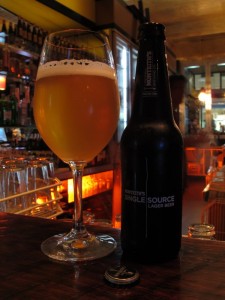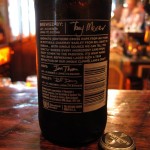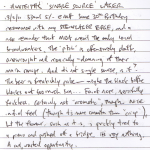
Once more unto the brandwank, dear friends, once more.
— Not quite Henry V
This one positively reeks of being a project out of the marketing department rather than one with its origins in the brain of a brewer, beer drinker, or normal person. At the time I’m putting this post together (in early July), a cursory Google search still more-readily produces write-ups concerning the beer’s branding (such as its packaging and website) than it does things which address, you know, the beer itself. The ‘pitch’ is simple: a beer produced using ingredients from just one barley farm, and just one hop farm.
But immediately, of course, there’s a snag. That’s not “Single Source” at all. I’ve mentioned two farms already. And then there’s a brewery in Timaru — not at either farm, and not anywhere near the home of Monteith’s in Greymouth on the West Coast. The water is from the area around the brewery, but the yeast is from god-knows-where and doesn’t actually rate a mention. So that’s four sources for a modern beer’s four canonical ingredients, two (i.e., half) of which aren’t really discussed, and a muddling of a historic (small-town) brewery with a modern (national) ‘brand’. If they were talking about an estate beer, made with barley and hops grown at the brewery, it might be worthy of the title — and such things do exist.1 Here, they’ve gone 1) catchy name, 2) half-assery.
Their precious Latitude / Longitude references don’t even make any damn sense. The location given for the origin of the hops — with its six decimal places — traces them to the grower’s front garden, rather than his fields. There’s some mention of the hop-farmer thinking his Southern Cross hops were particularly suited to the ‘microclimate’ in his garden in the official writeup, but there don’t appear to be any actually growing in that part of his property, and if they are just from his front yard, how ridiculously few have they used? Then, the coordinates for the barley — with their even-more-insane seven decimals — appear to point to the farmer’s driveway, or at least the hedgerow that runs along it. Something’s amiss; given their relative proportions in the brewing process, there’s just no way you could be more precise about the source of your barley than of your hops. And I called attention to their decimal places for good reason: six digits narrows you down to a tenth of a metre, seven digits basically gets you within a single centimeter. It’s an utterly stupid degree of “accuracy”, one that is just bursting with wank and ironically so “precise” it’s just obviously wrong. Three decimal places would pinpoint an area of roughly a hundred-or-so metres, and would thereby count as information rather than just bullshit.
On top of that, as Matt Kirkegaard pointed out (when he held his nose and read their over-inflated press release), it’s an absolutely bizarre kind of self-undermining bullshit if you stop to think about it for more than a second. It accidentally implies all sorts of terrible things about the beers in the same range: that they’re made without any real care or attention paid to the quality of their ingredients, that they’re utterly divorced from their roots (fitting for ‘Radler’, perhaps, but hardly inkeeping with the story for their ‘Original Ale’), and they’re not really worth protecting from getting lightstruck and skunked. If you go to conspicuous lengths to emphasise something apparently-worthy about one of your products, it starts to look rather odd that you aren’t really worried about that allegedly-serious concern when it comes to your others.
This isn’t remotely unique to Monteith’s and “Single Source”, of course. The same thing happens with the aggressively ‘all-natural’ marketing of Steinlager “Pure” — just what the fuck sort of witchcraft and chemical buggery and radioactive goo are they telling me is lurking in regular Steinlager? It’s probably partially a by-product of different projects being farmed out to different ad agencies, but it’s in particularly stark relief with this black-bottled, relentlessly brandwanked beer — especially given the fuckups the execution of its ‘story’, and the incredible sameyness of the product. And they have the unmitigated gall (amidst a fancy-pants website that tries desperately to be Down Home and simultaneously Ultra Modern) to describe their goal as:
A beer that didn’t need to rely on hype to be appreciated. A beer for the love of beer, if you like.
To which I have two-and-a-half responses: 1) like balls — and 2) if that was the plan, then a) you failed, and b) why all the, you know, hype? The beer isn’t terrible, at least. It’s the usual kind of basically-faultless but basically-featureless sort of thing we’ve come to expect from this corner of the market. It felt a bit like the label copy had been written in advance, or by someone who’d never met the beer (or perhaps a dictionary); it definitely wasn’t “aromatic”, though it did have a funk-free and pleasant mild nose, and it was certainly more in the realm of what normal people would call “smooth” than “crisp” (the lager-advertiser’s fallback adjective).
If we put it in its proper context of overly-marketed mild-to-flavourless lagers with delusions of grandeur, then I suppose I’d rather have one of these than a Budweiser. In that sense, and in that sense alone, it’s alright. But, to borrow the masterful conclusion from Hadyn Green’s piece on the subject:
In the end the fakers always lose, or run off following some other trend… Craft beer is like comic collecting, antiquing, cave diving, wine drinking or any other hobby — the interest for the enthusiast is the story. But the story can’t be tacked onto a paper-thin attempt. No one cares about the director’s commentary on a terrible film.
The beer itself is a non-disaster, and yet everything about “Monteith’s Single Source” is a clusterfuck of awfulness. Each word literally fails; the ad-man’s version of the world requires that you 1) ignore “Monteith’s”, lest you think less of their other products for lacking the prized black bottle, 2) not understand the word “single” or have any idea what goes into a beer or how many varieties might be used, and 3) not actually look up the “source” using the coordinates provided, in case you realise that their absurdly long string of digits is rather hollow and stupid and possibly some peculiar sort of geographical / mathematical equivalent to the kind of large, flashy (and, you know, overcompensatory) cars some men feel the need to be seen driving.
Verbatim: Monteith’s ‘Single Source’ Lager 13/5/11 330ml 5% @ MH Some 30th Birthday resonance with my Steinlager Edge, and a nice reminder that Moa aren’t the only local brandwankers. The ‘pitch’ is offensively daft, overwrought and ironically-damning of their main range. And it’s not single source, is it? The beer is freakishly pale — maybe the black bottle blocks out too much sun… Faint nose, mercifully funkless. Certainly not “aromatic”, though. Nice intial feel (though it’s more smooth than “crisp”), but the flavour, such as it is, is quickly tied to a piano and pushed off a bridge. It’s very nothing. A sad, wasted opportunity.
1: So no, marketing division, this isn’t “a revolutionary new beer”. Even if you had made something genuinely “single source”, you wouldn’t have been the first.



You were a lot more polite on the flavour and aroma than I’d have been. I had this beer with a very open mind, having just been involved in judging the Monteiths Beer and Wild Food challenge (irony alert, I know), and having been fairly impressed with how the Monteith’s range have cleaned up lately. Nary a banana ester to be found, and the Original was almost a good best bitter! So yeah, though the brandwanky product itself enraged me beyond belief, I actually expected a dull but clean zippy pilsner. Instead, I got a sweet, muddled, slightly syrupy (or “smooth”, if one is being polite) mess-in-a-glass. I couldn’t finish it.
I got given a free one once on a visit to The Occidental with my dad. Haven’t had one since. Rather have their Black or Pilsner over this over-priced, over-hyped bottle of bland.
Also, are they actually doing any other “sources” than the two they started out with. That would have made the concept much more interesting.
Nicely put in regards to the brandwank but my opinion of the flavour/aroma, like Greig actually states and Jono implies, is far less flattering.
I had one at Wellington Airport with Jed “Not My Real Name” Soane (of http://www.thebeerproject.com) on the way down to Blenheim for our Rescue Red brew with 8 Wired and Renaissance. We’d headed towards Mojo, where the idea of a Tuatara APA seemed like the perfect start to the trip, but they’d closed the upstairs bar early that night. There were few options left, and plenty of time to wait, so we decided to give the ‘SS Brandwank’ a crack. It was far milder in flavour and aroma than any of the other beers in Monteith’s range… which immediately had me thinking that they were pushing this in the “Pure” direction without using the word itself. The standout character in both departments, especially in the mouth, was more “grainy” than malty or hoppy. In fact, it was verging on “husky”, without any other feature to redeem it. The hops were a very lemony, in a Palmolive kind of a way. I was pretty surprised because, like Greig, I have found pretty positive characteristics in the few recent samples of Montheith’s that I have tried.
I’d be very surprised if it is still around in a year.
ps. Love the comment on the pale colour and its relation to the bottle colour.
Totally agree with the comments re branding. I also found fault with the actual beer on a tech level. When I had one months ago there was certainly the grainy character Stu talks of and a big dose of DMS. I like and share your response “Balls” .
I’m a little freaked out at the thought I might appear polite here. I’m the first to admit that I don’t have the most refined fault-detecting nose (and that’s partly intentional), but I’m certainly capable of being freaked-out by obviously-errant flavours such as the ones lurking in those Stoke beers I had, way back, or the ones that were alarmingly-common in the ‘Chosen One’ beers Martin Craig and I sampled recently. Maybe I just got lucky. My bottle of Single Source was boring, but it didn’t scream “broken”, to me.
And since it seems people do read the literal Diary entry, I should explain the Steinlager Edge reference and resonance. Minutes after midnight on my 30th birthday (after signing off from work), I had a bottle of ‘Edge’ as my first beer of my thirties. It’d been launched not-too-long previously, and the brandnonsense was chock with stuff about how “you” (male in your thirties) now had responsibilities, a family, a meeting and nine o’clock — and so you needed “controlled fun” in the form of their midstrength lager. I couldn’t really be further from the marketing demographer’s idea of a 30-year-old, but I decided I would “do as I was told”, and try one.
It was predictably horrific. But swiftly followed by all sorts of good stuff, since the pub was full of brewers who had all just survived the Beervana festival, and found themselves moved to shout me various wonderful things, bless them.
Anyway, I had my ‘Single Source’ on the occasion of my sister’s thirtieth, straight after I signed off and before I wandered over to Southern Cross to have a few beers (good beers, there; PKB and all sorts) with her and her friends. So there was a certain sort of sense in having another brandwank-drenched piece of nonsense, that day.
Thankfully, I’m out of siblings. No more 30th birthdays in my generation of my family. But I guess that just means I’ll have no one else to blame when I force myself to have another one of these horrid kinds of things, just to keep ‘calibrated’ and to furnish an excuse for a rant.